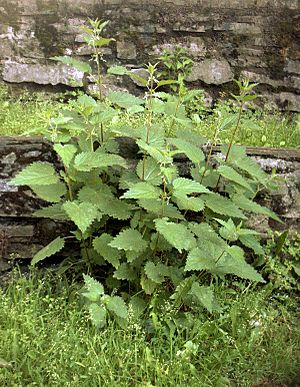Histamine facts for kids

The stinging nettle uses Histamine to protect itself.
Histamine is an organic nitrogenous compound involved in local immune responses. It also regulates physiological function in the gut, and acts as a neurotransmitter. Histamine is involved in the inflammatory response, where tissues get red, swollen and painful.
As part of an immune response to foreign pathogens, histamine is produced by basophils and by mast cells found in nearby connective tissues. Histamine increases the permeability of the capillaries to white blood cells and some proteins. The cells get through the walls of the tiny blood vessels to get at pathogens in the infected tissues.
Histamine in water exists as two tautomers in equilibrium, differing by the position of the hydrogen atom:
Images for kids
See also
 In Spanish: Histamina para niños
In Spanish: Histamina para niños

All content from Kiddle encyclopedia articles (including the article images and facts) can be freely used under Attribution-ShareAlike license, unless stated otherwise. Cite this article:
Histamine Facts for Kids. Kiddle Encyclopedia.


